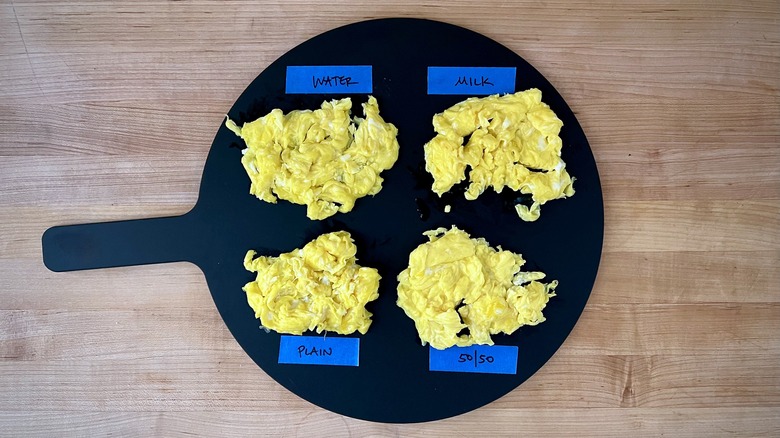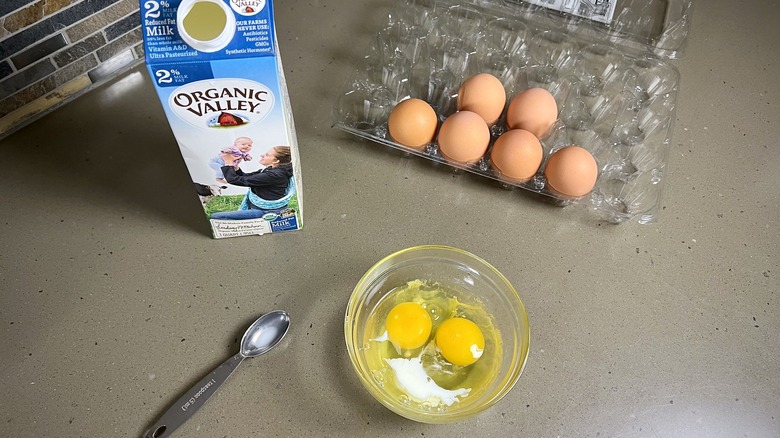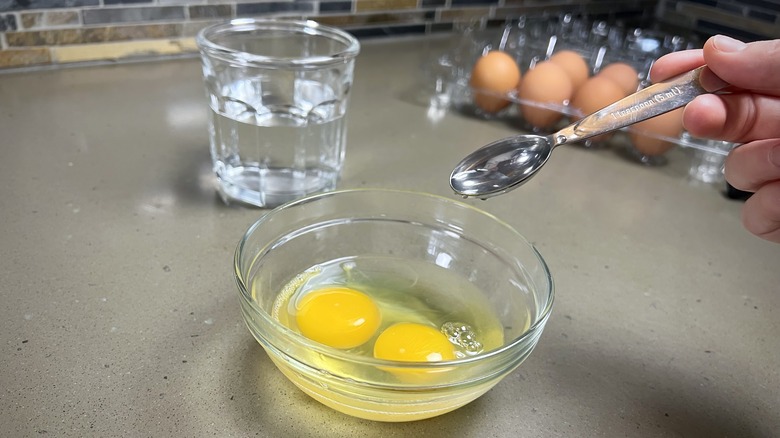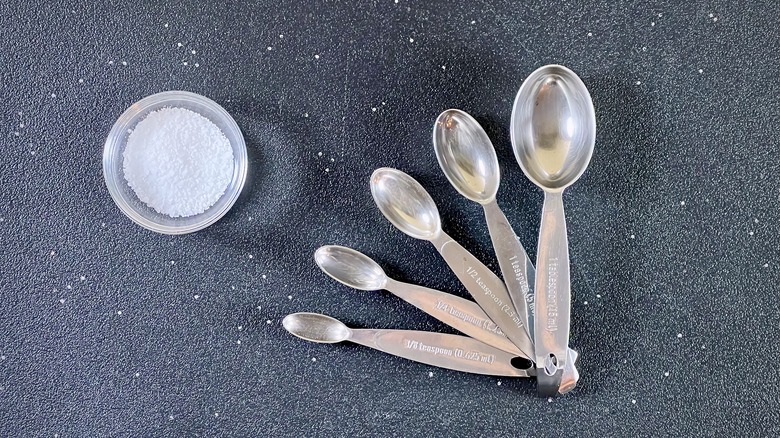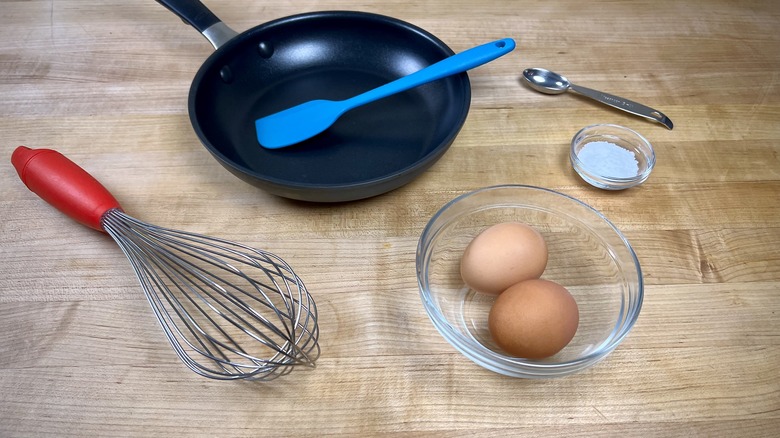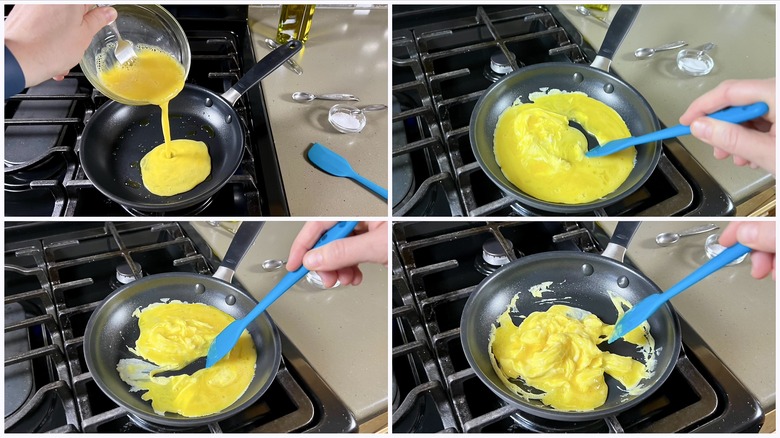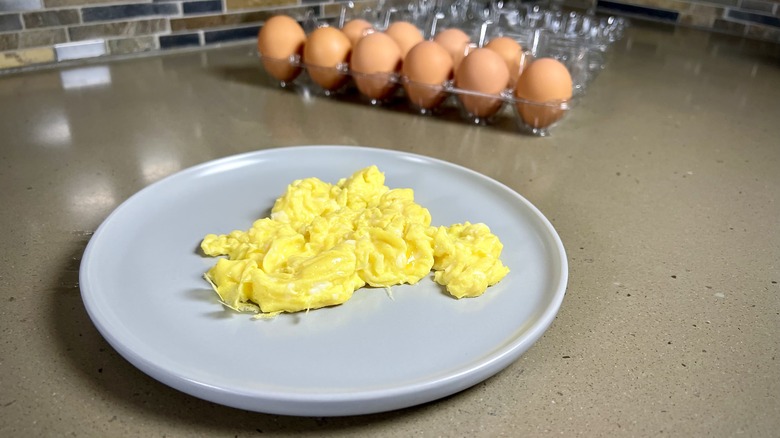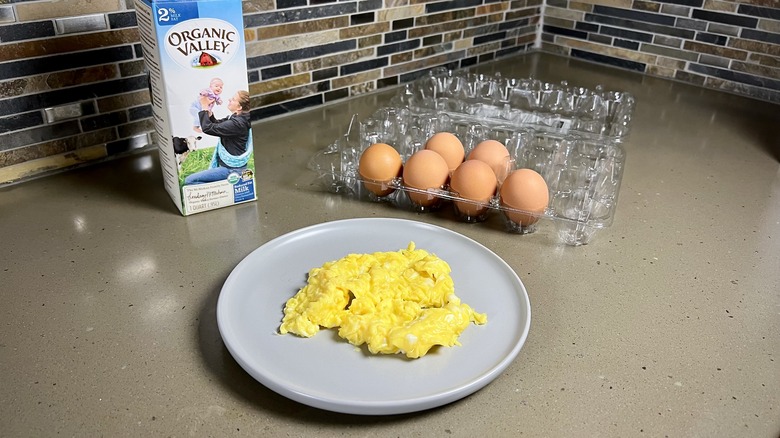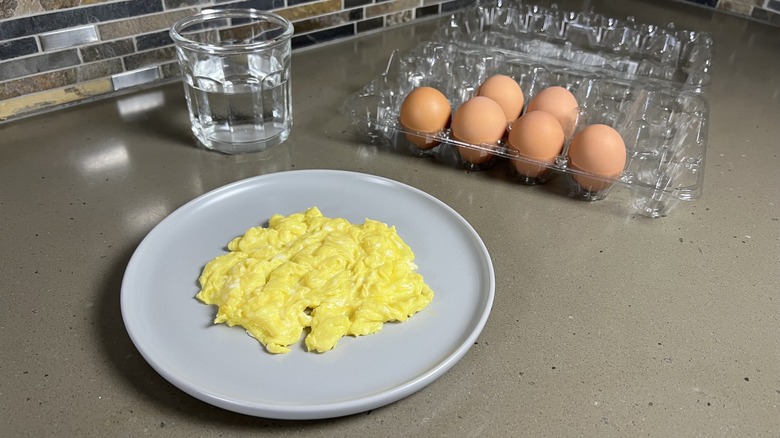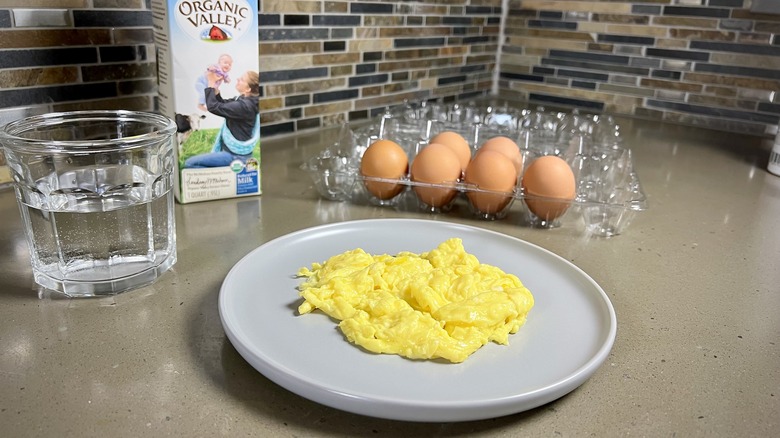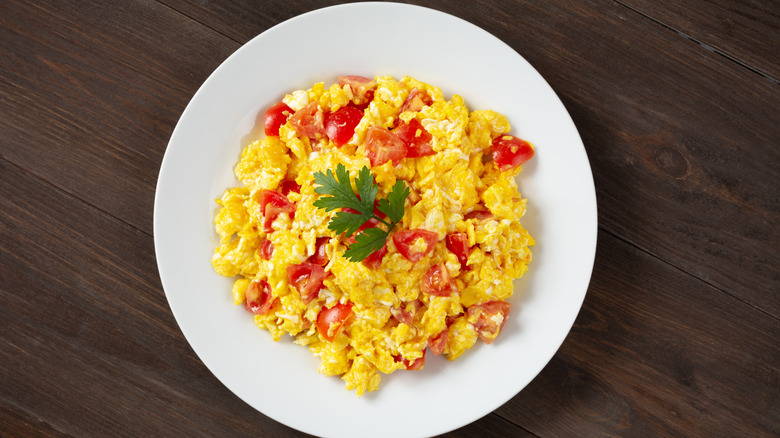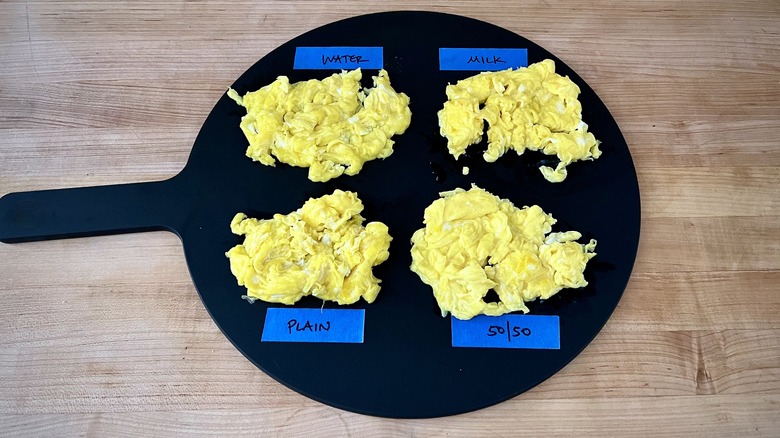Water Vs. Milk: Which Is The Better Addition To Scrambled Eggs?
Scrambled eggs are one of the first things that most of us learn to cook. They're deceptively simple compared to more advanced cooking tasks like grilled steak or roasted vegetables. Simply crack a few eggs into a bowl, give them a lazy whisk, and pour the mixture into a preheated skillet — no culinary training required. But here's where the "deceptive" part comes in. Agitate them too much while cooking or overcook them, and the eggs will taste rubbery and dull. There's no margin of error, either: If you don't move them enough, they won't fluff up as they cook, and undercooked eggs turn into a gross, snotty pile of wet curds.
Most celebrity chefs have an egg-cooking hack, like Gordon Ramsay's trick for scrambled eggs or how J. Kenji López-Alt combines two tips for creamy scrambled eggs (spoiler alert, it's a cornstarch-milk slurry and cold butter). Among the tricks are two liquid additives — milk and water — that allegedly create some of the best scrambled eggs. To determine whether this hack holds up, we scrambled a set of eggs without any additions, using them as a baseline to compare to eggs made with water, milk, and a 50/50 mixture. We evaluated each batch's texture, consistency, and flavor to determine the winner. After eating way more eggs than anyone should in one sitting, we were a little surprised at which was our favorite.
Adding milk to scrambled eggs is supposed to make them creamier
We weren't able to find a single person or source credited with the idea of adding milk to scrambled eggs, so we assume this is just one of those well-known cooking tips that's been passed from generation to generation. The basic idea here is that the milk will increase the egg's fat content, resulting in scrambled eggs with a creamier consistency and a rich, buttery edge.
Unfortunately, milk (even whole milk) doesn't have that much fat. Depending on the breed, cow's milk can range from 3 to 5.5% fat, with the remaining percentages made up of protein, lactose, and water. That means that it's mostly just water, which critics of the milk-adding technique say will water down the egg and dilute its flavor. There's also the matter of the extra protein content from the milk. You see, the protein in eggs naturally unwinds as they're heated, forming new bonds with water or air in the process. When overheated, these bonds tighten and can squeeze out moisture from the eggs, leading to a dry, rubbery product. That's why so many modern chefs recommend that you should think twice about putting milk in your scrambled eggs. The protein-rich mixture becomes easier to overcook, leading to the dreaded rubbery egg.
Using water instead of milk is supposed to make scrambled eggs fluffier
Adding water to eggs is another adage that's been around for a while. Like the milk technique, we couldn't find the method's origin, but it has become popular recently in food science circles. The idea here is that adding water to scrambled eggs creates steam that interrupts the way that proteins come together as they're heated. London-based food scientist Natalie Alibrandi told Well + Good that the water prevents the proteins from bonding too quickly, buying you a little more time before the eggs get firm and dry. Since the water also creates steam as it evaporates, it results in a fluffier egg.
From a practical standpoint, we also see the water method as beneficial for several reasons. It's not only less expensive than milk, but it also doesn't require a special trip to the store if you don't have it on hand. Although a splash of milk isn't going to crash your calorie bank, it's also worth noting that water adds no nutritional value to the eggs.
How we determined the right quantity of liquid and salt for our scrambled eggs
Beyond the debate between water vs. milk, we also had to ask ourselves how much liquid to add to our scrambled eggs. We've seen guidelines ranging from ½ teaspoon to 1 tablespoon per egg, so we did a quick test batch and found that a little goes a long way. The eggs made with less than 1 teaspoon per egg turned out best, while the eggs with a full tablespoon lacked the savory flavor we've come to know and love in scrambled eggs. You'll also lose the egg's vibrant yellow color as you dilute the mix with additional liquid.
We also debated whether or not to salt the eggs. Remember that our goal here is to cook the eggs just to the point where they're done while avoiding the moment where the proteins bond and squeeze out the excess water. Adding salt can improve the texture of scrambled eggs because it acts like a buffer between the proteins while lowering the temperature when coagulation happens. Science aside, we tried a batch with and without the salt, and the salted eggs retained more moisture. So, that was definitely the way to go.
Required cooking equipment
Finally, you'll need a few pieces of cooking equipment to make the perfect scrambled egg. For starters, that means a nonstick pan. Yes, you can use a well-seasoned carbon-steel or cast-iron skillet if you like, but nonstick pans really do make life easier. Most are made with an aluminum base, which heats up quickly and evenly. Plus, the nonstick surface means you can use less oil and it will be easier to stir the eggs without any sticking or scraping. You'll also need a rubber spatula to do all that stirring. Make sure to pick one that's comfortable to hold because you'll be using it to move the eggs pretty much constantly as they cook.
Finally, you'll need a small bowl and a whisk or a fork. If you're feeling lazy, you can absolutely crack the eggs directly into the pan and scramble them as they heat, but you won't get the true scrambled egg experience. Egg yolks and whites have different compositions of water and proteins, and all the fat is contained in the yolk. Proper whisking ensures a homogenous mixture that allows the egg to cook evenly. You don't need to go overboard when whisking here; just mix until it looks consistent. Some chefs prefer using a fork to scramble eggs because it reduces the amount of air whisked into the mixture, which can make them rubbery.
The process of making scrambled eggs
Regardless of our additives, the process of making scrambled eggs remained the same for each test batch. We cracked two eggs into a small bowl and added a teaspoon of liquid and ⅛ teaspoon of salt. For the plain, baseline batch, we omitted the added liquid. While we whisked the eggs with a fork until the yellow and white parts were well-mixed, we preheated an 8-inch nonstick skillet with ⅛ teaspoon of avocado oil. Some chefs will tell you that eggs have to be scrambled in butter, and we would normally follow that rule because it adds richness and flavor. In this instance, we wanted to taste the eggs — not the cooking fat — so we went with the neutral oil.
There are many different theories on making the perfect scrambled egg, but we've always been a fan of using medium-low heat. Classic techniques use very low heat, but they also can take up to 30 minutes to scramble an egg, and who has time for that? After pouring the eggs into the preheated pan, all you need to do is gently move the eggs around with the spatula, shaking the pan as you go so the raw egg flows into the empty spaces. You can take the pan on and off of the heat if it gets too hot. Then, when the eggs are almost finished cooking, remove the pan from the heat and transfer the eggs to a plate. They may look slightly undercooked, but they'll undergo carryover cooking as they sit.
How did the eggs without added liquid taste?
We started by making the plain eggs to have a baseline to compare with the other eggs. Using our medium-low heat setting, the eggs cooked in almost exactly two minutes. Although they had no added liquid — just added salt — we thought these eggs turned out pretty good. They had a nice chew and a good springiness, and they didn't feel too rubbery or soft from a textural perspective.
When it came to taste, we will say that the ⅛ teaspoon of salt was a skosh too much. The eggs tasted slightly over-salted for most of our palates. Were we to do them over again, we would certainly reduce the salt to a mere pinch when no added liquid was involved. That said, the eggs tasted ... well, eggy. They weren't overly rich or creamy, but they weren't cardboard-like or dry like we normally associate with poorly cooked eggs. It was proof that you don't actually need to add anything to scrambled eggs to make them taste great, but we were excited to see what the additions would do to the eggs.
What happened when we added milk to the mix?
Next up were the milk scrambled eggs, which had a teaspoon of cold milk added to the mix. Curiously enough, these eggs took a little longer to cook — 2 minutes and 15 seconds, or 15 seconds longer than the plain batch. The curds separated easily and moved independently as we stirred, creating more surface area than the plain eggs. While they didn't feel as rubbery as we expected given the science, they were slightly tougher than the plain eggs, with a lightly squeaky feeling as we chewed.
When we tasted the eggs, the first thing we noticed was salt followed by a lightly sweet aftertaste. Somehow, these eggs tasted less eggy than the plain eggs. It was like the savory notes had evaporated during the cooking process. They were creamy, but they didn't quite taste rich. Overall, we felt like these eggs missed the mark, but we might not have been able to put our finger on why if we hadn't tasted them side-by-side with the plain eggs.
How did the eggs made with water compare?
Our next batch was eggs scrambled with a teaspoon of room-temperature tap water. These eggs started sizzling as soon as they hit the preheated pan, even though it was the same temperature as the previous two batches. As we stirred the mixture, we noticed that the eggs were staying together, puffing up into a fluffy egg cake as the liquid turned to curds. The finished eggs held together in a firm clump, but they weren't tough. They were airier than the plain eggs, and pleasantly springy when we chewed.
These eggs only took 1 minute and 45 seconds to cook — a little bit faster than the plain eggs, and a lot faster than the milk eggs. The first taste to hit our palate was savory egginess, which faded to a slightly salty aftertaste on the back of the tongue. While the flavor was an improvement over the plain eggs, we wouldn't say they were particularly rich. The creaminess seemed to be diluted, even though we only added a small amount of liquid.
What happened when we used a mix of both?
At this point, we were starting to think that the plain eggs might be the best in the test group, but we hadn't finished our experiment. Last up was a batch of eggs that used a mixture of both: ½ teaspoon cold milk and ½ teaspoon room-temperature water. The eggs took two minutes to cook, the same amount of time as the plain eggs. These eggs had the same fluffy, springy feel as the water eggs, so we had no complaints from a textural standpoint.
When it came to flavor, we were surprised to note that these were the least salty eggs in the group. All the other eggs had a noticeable salt presence at some point in the tasting experience, but these eggs simply tasted seasoned. They also had a pronounced savory, egg-forward flavor and a richer, creamier texture than the plain eggs. After eating so many different batches of eggs, you would think our palates would be exhausted by this point, but these eggs were so good that we actually wanted to keep eating them.
Best uses for scrambled eggs
Scrambled eggs taste great on their own, so don't be afraid to serve them in a classic way with a side of potatoes, toast, and the meat or veggies of your choice. There's also nothing wrong with wrapping them up in a tortilla to make a breakfast burrito or plopping them between two pieces of bread to make a sandwich. Keep in mind that scrambled eggs with small curds (the ones produced when you move them around a lot) will fall out of a breakfast sandwich, so you might want to bind them together by melting some cheese on top. Better yet, stuff them inside the sandwich and cook them grilled-cheese style to hold them together.
It's also worth considering what you want to add to your scrambled eggs. There are several ways to amp up scrambled eggs, from adding meat, cheese, or vegetables like chopped tomatoes to the mix. You can also enhance their flavor by cooking them in bacon grease or adding richness with truffle butter. Don't be afraid to scramble your eggs with unorthodox ingredients, either, including chopped-up pizza to make TikTok's "Pizza Eggs" trend.
The verdict: Which is the best addition to scrambled eggs?
Regarding rankings, we determined that the milk eggs were our least favorite. While they did have excellent creaminess, the actual egg flavor was diluted and they had an odd, squeaky texture that we didn't love. Next up, we chose the plain eggs, which were surprisingly good despite the lack of additives (although the tasters all noted they'd like a little less salt next time around). Our second favorite was the water eggs, which cooked quickly, tasted seasoned, and had a fantastic fluffy texture.
The winner of the group: the 50/50 eggs. Using half milk and half water seemed to create the best of both worlds, producing a scrambled egg with the creamiest consistency, the best flavor, and a light, airy texture. They cooked up into a perfect blend of large, soft curds that held together if left unagitated but separated easily into clumps with a little prompting from the spatula.
Once we're ready to eat eggs again, we may find ourselves making the water eggs because they don't require a trip to the grocery store. But if we have milk in the fridge or we're cooking breakfast for guests, we'll definitely add a splash of milk to the mix to make the perfect scrambled eggs.
